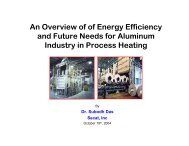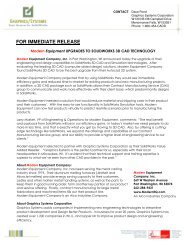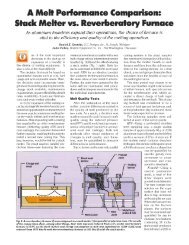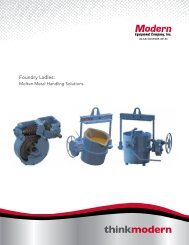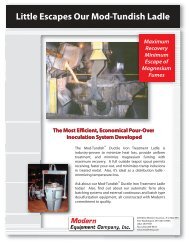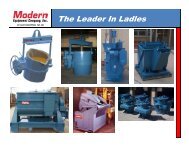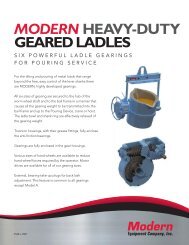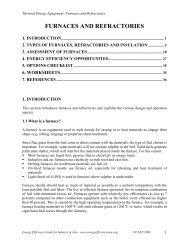ITP Metal Casting: Advanced Melting Technologies: Energy Saving ...
ITP Metal Casting: Advanced Melting Technologies: Energy Saving ...
ITP Metal Casting: Advanced Melting Technologies: Energy Saving ...
Create successful ePaper yourself
Turn your PDF publications into a flip-book with our unique Google optimized e-Paper software.
A vertical tube-within-tube convective recuperator is an alternative arrangement of the<br />
convective recuperator where the cold combustion air is heated in a tank of parallel vertical tubes<br />
extending<br />
in to the path of flue gas stream. The tube is easy to replace during full operation,<br />
minimizing cost, inconvenience, and equipment damage from forced shutdowns in case of<br />
recuperator failures. 67<br />
4.3.2 Refrigeration<br />
Absorption chillers use heat instead of mechanical energy to provide cooling for applications<br />
such as air conditioning.<br />
They transfer their thermal energy from the heat source to the heat sink<br />
through an absorbent fluid and a refrigerant. The two most common refrigerant/absorbent<br />
mixtures used in absorption chillers are water/lithium bromide and ammonia/water. The<br />
absorption chiller creates refrigerating effect by absorbing and then releasing water vapor into<br />
and out of a refrigerant solution (Exhibit 25). 68<br />
Source: Gulf Coast CHP Application Center<br />
Exhibit 25: Simplified absorption cycle<br />
Absorption chillers are economically attractive because they utilize<br />
inexpensive thermal energy<br />
(waste heat). Mechanical chillers must be driven by motor or engine; however,<br />
absorption<br />
chillers primarily use low-grade waste heat at a temperature between 100°C and 200°C (212°F<br />
and 392°F). These chillers can change a building’s thermal and electric energy and cost profile<br />
by shifting cooling needs from an electric load to a waste-heat thermal load.<br />
4.3.3 Regenerators<br />
A regenerator is a container that is capable of absorbing and storing large amount of thermal<br />
energy. It is charged with<br />
the hot exhaust gas during the melting operation cycle; when the<br />
regenerator is fully charged, it stops the flow of the exhaust gas and starts allowing in<br />
27



